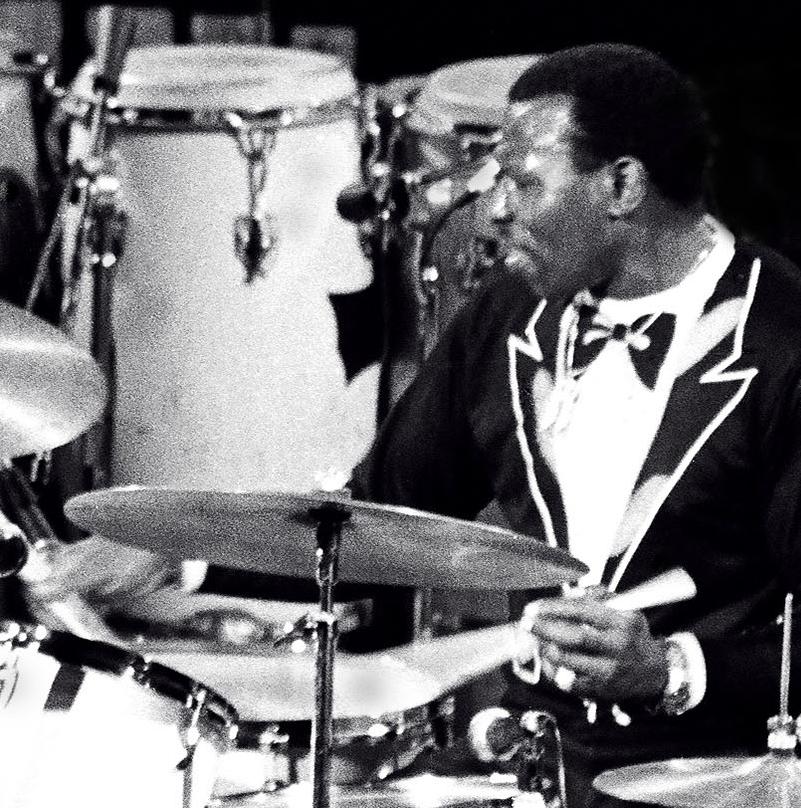- Elvin Jones
Infobox musical artist
Name = Elvin Jones

Img_capt = Elvin Jones in 1976
Img_size =
Landscape =
Background = non_vocal_instrumentalist
Birth_name = Elvin Ray Jones
Alias =
Born = Birth date|1927|9|9
Died = death date and age|2004|5|18|1927|9|9
Origin =Pontiac, Michigan ,United States
Instrument = drums
Voice_type =
Genre =Modal jazz Avant-garde jazz Hard bop Mainstream jazz Post-bop
Occupation =Drummer
Years_active =
Label =
Associated_acts =John Coltrane ,Charles Mingus ,Thad Jones ,Hank Jones
URL =
Current_members =
Past_members =
Notable_instruments =Elvin Ray Jones (
9 September 1927 –18 May 2004 ) was one of the most influential jazz drummers of thepost-bop era. He showed interest in drums at a young age, watching the circus bands march by his family's home inPontiac, Michigan . He served in theUnited States Army from 1946 to 1949 and subsequently played in aDetroit houseband led by Billy Mitchell. He moved toNew York in 1955 and worked as a sideman forCharles Mingus -Teddy Charles ,Bud Powell andMiles Davis .From 1960 to 1966 he was a member of the
John Coltrane quartet, perhaps his most celebrated recording phase, appearing on such albums as "A Love Supreme ". Following his work with John Coltrane, Jones led several small groups, some under the name The Elvin Jones Jazz Machine. He recorded with both of his brothers during his career, jazz musiciansHank Jones andThad Jones . His later career saw him working with many of the younger jazz artists of today, includingBill Frisell .Biography
Early life
Elvin Jones was born in
Pontiac, Michigan . By age two he said he knew he held a fascination for drums. He would watch the circus marching band parades go by his home as a boy, particularly fascinated by the drummers (sometimes wandering off for miles after the parade). Following his early passion, Elvin joined his high school's black marching band, where he developed his foundation inrudiments . Jones began service in theUnited States Army in 1946. He was discharged in 1949, and returned home penniless. Jones said he borrowed thirty-five dollars from his sister when he got back to buy his firstdrumset . [cite web| last = Gross| first = Terry| title = Elvin Jones NPR interview| url=http://www.npr.org/templates/story/story.php?storyId=1905210| accessdate = 2007-05-30 ]1949-1960: Early career
Elvin began his professional career in 1949 with a short-lived gig in
Detroit 's Grand River Street club. Eventually he went on to play with artists such asCharlie Parker ,Miles Davis , andWardell Gray . In 1955, after a failed audition for theBenny Goodman band, he found work inNew York , joiningCharles Mingus 's band, and releasing a record called "J is for Jazz".1960-1966: John Coltrane and Beyond
In 1960, he joined with the classic
John Coltrane Quartet, which also included bassistJimmy Garrison and pianistMcCoy Tyner . Jones and Coltrane often played extendedduet passages, both giving and taking energy through their instruments. This band is widely considered to have redefined "swing" (therhythm ic feel of jazz) in much the same way thatLouis Armstrong ,Charlie Parker , and others did during earlier stages of jazz's development. He stayed with Coltrane until 1966. By that time, Jones was not entirely comfortable with Coltrane's new direction and hispolyrhythmic style clashed with the "multidirectional" approach of the group's second drummer,Rashied Ali .Jones remained highly active after leaving the John Coltrane group, and led several bands in the late sixties and seventies that are considered highly influential groups. Notable among them was a trio formed with saxophonist and multi-instrumentalist
Joe Farrell and (ex-Coltrane) bassistJimmy Garrison , with whom he recorded the Blue Note album "Puttin' It Together". Jones recorded extensively for Blue Note under his own name in the late sixties and early seventies, with groups that featured prominent as well as up and coming greats. The two volume "Live at The Lighthouse" showcases a 21- and 26-year-oldSteve Grossman andDave Liebman , respectively. Other musicians of note who made significant contributions to Elvin's music during this period were baritone saxophonistPepper Adams , tenor saxophonistsGeorge Coleman andFrank Foster , trumpeterLee Morgan , bassistGene Perla , keyboardistJan Hammer andJazz -World Music group Oregon.Late career
Elvin Jones' sense of timing,
polyrhythm s, dynamics,timbre , andlegato phrasing - as well as the sheer mass of sound he produced - brought the drumset to the foreground. Jones was touted byLife Magazine as "the world's greatest rhythmic drummer", and his free-flowing style was a major influence on many leading rock drummers, includingMitch Mitchell (whomJimi Hendrix called "my Elvin Jones") andGinger Baker . In 1999, Jones worked withOur Lady Peace on their album "Happiness...Is Not a Fish That You Can Catch ". He was featured playing drums on the song "Stealing Babies".Educator
Jones, who taught regularly, often took part in clinics, played in schools, and gave free concerts in
prison s. His lessons emphasized music history as well as drumming technique.Death
Elvin Jones died of heart failure in
Englewood, New Jersey onMay 18 , 2004. He is survived by his first wife Shirley and his second, albeit common-law, wife Keiko (Elvin married Keiko before divorcing Shirley, meaning that legally he and Keiko were not married). Elvin Jones is also survived by his son Elvin Nathan Jones of California and daughter Rose-Marie From of Sweden. Chicago. Not pictured are
Chicago. Not pictured are Jimmy Garrison on bass andJoe Farrell on soprano saxophone.
Original photographs and story by [http://www.flickr.com/photos/joeyharrison/1354576855/ Joey Harrison]Discography
As leader
As sideman
References
External links
* [http://www.elvinjones.com/ Elvin Jones Official Site]
* [http://www.jazzdisco.org/elvin-jones/catalog/ Complete Elvin Jones Discography]
* [http://www.drummerworld.com/drummers/Elvin_Jones.html Elvin Jones at "drummerworld.com"]
* [http://stream.realimpact.net/rihurl.ram?file=realimpact/iaje/nea2003/jones/bio_jones2.rm NEA Jazz Masters video biography of Elvin Jones narrated byBilly Taylor ]
* [http://stream.realimpact.net/rihurl.ram?file=realimpact/iaje/nea2003/jones/backstage_jones.rm Elvin Jones Interview from NEA Jazz Masters]
* [http://www.youtube.com/watch?v=Ytz1ZKk9wXw Elvin Jones with the John Coltrane Quartet performing "Afro Blue" on Ralph Gleason's "Jazz Casual", 1963]
* [http://www.jazz.com/dozens/dozens-essential-elvin "Elvin Jones: Twelve Essential Recordings"] by Eric Novod ( [http://www.jazz.com Jazz.com] )
Wikimedia Foundation. 2010.
